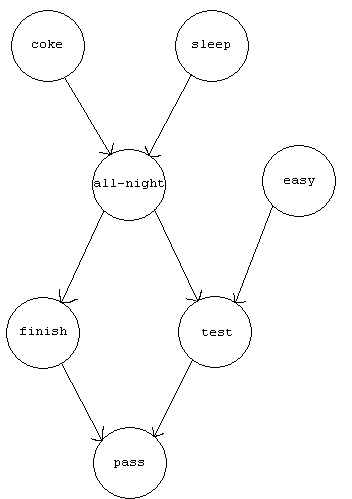Homework #2: Proof of Concept
This assignment will be performed by individuals. We encourage you to
discuss problems or insights, but you should perform the work
yourself.
Assignment Overview
The assignment consists of a set of questions on logic (first-order
logic and propositional logic) and a set of questions on uncertainty
(Bayes nets).
Logic
The logic section has three parts which should occur in sequence.
- Transform the given problems into first-order logic. You should
have expressions describing the knowledge base and queries. You may
use any reasonable connector/logical function (quantifiers,
implication, negation, disjunction, conjunction, ...).
- Define a finite universe for each quantified variable in the problem and
rewrite the problem in propositional CNF form using the
translation engine.
- Run the CNF formula through a solver (we are providing
you a and problem domain with which you
can use with your search engine to solve CNF problems). Translate the
resulting truth assignment into a solution for the FOL problem as well
as the actual questions.
Problems
These problems come from the GRE (graduate record examination) section
on analytical reasoning. Look up problems one
and three
in the analytical
reasoning section of ETS's GRE practice questions. These define
two separate scenarios each with one question. Encode the scenarios as
the knowledge base and the answer choices as statements which are
satisfiable in the given KB if and only if they are correct.
Solvers
Use the FOL
to CNF translator to construct the CNF version of your problem
(comments on how to use the translator are in the file).
Use the SAT
problem for your search engines to solve the propositional
formulas. There are comments on how to use the SAT problem in the
code.
Note: you need not use your own team's engine to perform the
search. You may use another team's.
Questions
- What was the most difficult part of constructing your encoding?
- Did you need to encode any information that was not explicit in
the problem?
- What advantages or disadvantages did encoding into FOL and then
translating to CNF propositional form have over simply encoding in
CNF? Did the advantages differ between the scenarios?
- Give one characteristic that you could have added to one of the
problems that would have made it more difficult to translate into
propositional form.
- Was the previous bullet really a question?
- What about this bullet?
- As always: what was right and wrong with this assignment? What did
you learn? What was exciting? What would have been fun to do next (if
only we had the time)?
Uncertainty
Consider the following Bayesian network:

The nodes in the graph are tied to the following events:
- sleep
- You got a good night's sleep on Tuesday.
- coke
- There's Coke in the drink machine Wednesday night.
- all-night
- You manage to stay up working on the homework all night Wednesday.
- easy
- The kindly professor made an easy exam.
- test
- You pass the test on Thursday.
- finish
- You finish the homework (due Thursday... maybe the prof's not so kindly).
- pass
- You pass the course.
Perform the following tasks using this network:
-
Write in reasonable numbers for the conditional probability of each
cause given its effects. All effects with multiple causes should be
noisy-OR style. No probability that you choose should be less
than 0.01 or greater than 0.99. Explain your choices briefly.
-
Note at least three separate conditional independences.
-
Give the formula for (no numbers) and the solutions of (only one
number) the following queries:
- P(all-night)
- P(pass|all-night)
-
Is this a polytree?
Note: your course grade is independent of your calculated probability
of passing given that you calculate it correctly.
Questions
Just one here: how would you have changed the links in this Bayes net
to more closely describe the situation (from your point of
view)?
Submission
You should submit a paper copy of the problems in FOL, propositional
logic, and CNF form as well as the solution to the problem. You should
describe your method for performing each step of the translation
(e.g., you encoded ball order with the predicate Before(ball1,ball2)
which means that ball1 has a lower number in the order than
ball2). You should mention insights and difficulties you ran into
along the path to passing this subset of the GRE.
For the second part, you should submit a drawing of the Bayes net
labelled with the probabilities. You should also submit paper copies
of your answers to the other questions.
No code submission necessary for this assignment!

